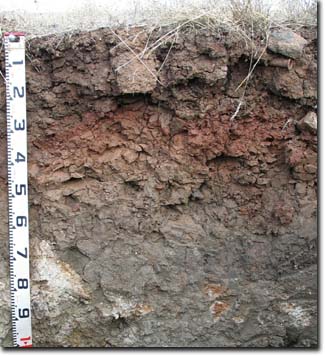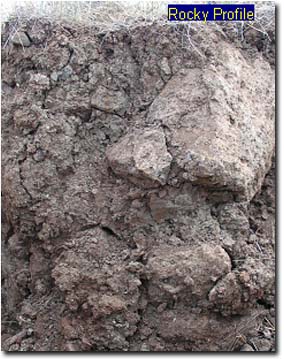PPW9
Location: Werribee - Research Farm
Aust. Soil Class.: Episodic, Epipedal, Grey & Red VERTOSOL (Stony)
Northcote Factual Key: Ug 5.22
Great Soil Group: grey, brown red clays
Previous Soil Type: (Skene 1954): Sunrise clay loam (basalt)
Maher and Martin (1979) map unit: 7
General Landscape Description: Level plain.
Site Description: Grazing paddock (adjacent to Sneydes Road and Hoppers Lane)
Geology: Quaternary basalt.
 WP6 Landscape |
Soil Profile Morphology
Surface Soil |  PPW9 Profile | ||
A1 | 0-10 cm | Brown (10YR4/3) with reddish brown (5YR5/4) mottles; light medium clay; strong coarse to medium polyhedralstructure; strong surface cracking; earthy fabric; pH 7.4: | |
Subsoil | |||
B21 | 10-30 cm | Light yellowish grey-brown (10YR6/4); light clay; moderate to strong coarse subangular blocky structure; strong consistence (dry); very few (1%) fine calcareous nodules (2 mm); earthy; pH 8.4: | |
B22 | 30-40 cm | Reddish brown (5YR5/4) and yellowish red (5YR5/6); medium heavy clay; rigid consistence (dry); slickensides present; some basalt fragments; pH 8.9: | |
B23 | 40-60 cm | Light brownish grey (2.5Y6/2) with few (5-10%) yellowish red (5YR5/8) mottles; heavy clay; rigid consistence (dry); slickensides present; pH 8.9: | |
B24k | 60-90 cm | Greyish brown (2.5Y5/2) with few (5-10%) yellowish red (5YR5/6) mottles; heavy clay; very strong consistence (slightly moist); many (20%) soft and semi hard fine-earth carbonates and calcareous nodules; large slickensides present; pH 9.2: | |
| B25k | 90-120 cm | Light brownish grey (2.5Y6/2); heavy clay; strong coarse to medium lenticular structure; very firm consistence (slightly moist); common (10%) soft and semi-hard calcareous nodules; very many (50%) weathered vesicular basalt fragments; slickensides present; pH 9.6: | |
 | Grey, rocky profile: | ||
A1 | 0-5 cm | Brown (7.5YR 4/4) medium clay | |
B21k | 5-45 cm | Light brownish grey (2.5Y6/2) medium clay; strong consistence dry; fine-earth carbonates and calcareous nodules common (10-20%); very many (> 50%) weathered vesicular basalt boulders. | |
B22k | 45-70 cm | Light brownish grey (2.5Y 6/2); heavy clay; fine-earth carbonates and calcareous nodules common (10-20%); very many (> 50%) weathered vesicular basalt boulders. | |
B23k | 70-110 cm | Light brownish grey (2.5Y6/2) with yellowish red (5YR5/6) mottles (20%); heavy clay; fine-earth carbonates common (10-20%); rigid consistence dry. | |
Key Profile Features
- Large amount of basalt rocks throughout soil profile.
- High clay content throughout soil profile.
- Vertic properties (i.e. slickensides, lenticular peds) – including strong profile cracking when dry.
- Large amounts of fine-earth carbonates (lime) in parts of the soil profile.
pH | Salinity Rating | |||
Surface (A1 horizon) | Slightly Alkaline | Low | Strongly Sodic | Slight – Moderate1 |
Subsoil (B21 horizon) | Strongly Alkaline | Low-Medium | Strongly Sodic | Strong1 |
Deeper subsoil (at 80-120 cm) | Very Strongly Alkaline | High | Strongly Sodic | Moderate |
| 1Complete dispersion after remoulding | ||||
 |
Horizon | Horizon Depth (cm) | pH (water) | pH CaCl2 | EC dS/m | NaCl % | Exchangeable Cations | Boron (CaCl2) mg/kg | Field pF2.5 | Wilting Point pF4.2 | Coarse Sand (0.2-2.0mm) | Fine Sand (0.02-0.2mm) | Silt (0.002-0.02mm) | Clay (<0.002mm) | |||
Ca | Mg | K | Na | |||||||||||||
meq/100g | ||||||||||||||||
A1 | 0-10 | 7.4 | 6.8 | 0.30 | 0.03 | 7.6 | 8.3 | 1.6 | 3.2 | 33.9 | 17.9 | 5 | 30 | 15 | 43 | |
B21 | 10-30 | 8.4 | 7.7 | 0.41 | 0.03 | 7.1 | 7.8 | 1.1 | 5.3 | 5.3 | 37.4 | 27.2 | 5 | 30 | 19 | 40 |
B22 | 30-40 | 8.9 | 8.4 | 0.99 | 0.21 | 6.4 | 15 | 2.0 | 11 | 13 | 60.6 | 17.4 | 3 | 19 | 12 | 61 |
B23 | 40-60 | 8.9 | 8.1 | 0.54 | 0.18 | 5.0 | 16 | 2.2 | 13 | 15 | 59.5 | 26.1 | 2 | 21 | 20 | 53 |
B24k | 60-80 | 9.2 | 8.6 | 0.60 | 0.16 | 4.1 | 18 | 2.1 | 13 | 43.2 | 25.1 | |||||
B25k | 80-120 | 9.6 | 9.5 | 0.67 | 0.20 | 4.5 | 21 | 1.9 | 15 | |||||||
<2µm Clay Mineralogy | |||||||
Horizon | Depth cm | Quartz | Mica/Illite | Kaolin | Goethite | Orthclase | Smectite |
B21 | 10-30 | 11 | 20 | 48 | - | <1 | 20 |
2µm Cation Exchange Capacity | ||||||||||||
Horizon | Depth cm | SiO2 % | Al2O3 % | MgO % | P2O5 % | K2O % | TiO2 % | MnO % | Fe2O3 % | BaO % | Sum % | CEC cmol/kg |
B21 | 10-30 | 47.5 | 22.7 | 1.1 | 0.4 | 1.8 | 1.3 | 0.0 | 9.0 | 3.4 | 87.1 | 45 |
Management Considerations:
Whole Profile
- The soil profile displays strong vertic features (i.e. cracking, slickensides, lenticular peds). This indicates that significant shrinking and swelling occurs during wetting and drying cycles. This may disturb the roots of some plants and has engineering implications (e.g. disturbance to fencelines and buildings).
- In many areas, the soil profile can contain a large amount of basalt rocks and boulders. This will result in variation across the paddock in soil depth and effective rooting depths.
- Disturbance of clayey soils like these should be avoided if the soil is wet (i.e. wetter than the plastic limit). At such moisture conditions, excessive tillage, trafficking or over-stocking could result in soil structural damage (e.g. compaction). Ideally, activities such as these should only take place on clay soils when the soil is drier than the plastic limit – down to at least the tillage depth.
- The surface soil is strongly sodic and disperses (completely after remoulding). This indicates again that structural degradation (e.g. surface sealing, increased cloddiness) can occur if the soil is cultivated or overstocked in a moist to wet condition. Also, raindrop action on bare soil will also promote dispersion and result in surface sealing or crust formation. Surface cover should be maintained to protect against raindrop damage. The use of gypsum will also assist in ameliorating the surface soil.
- The high wilting point value (i.e. 18%) indicates that plants will be unable to fully utilise light rains falling when the soil is relatively dry.
- The dense and coarsely structured subsoil is strongly sodic and dispersive. This indicates that root and water movement into the subsoil will be significantly restricted.
- The level of soluble salts becomes high from 30 cm depth which will restrict the growth of deeper-rooted salt sensitive species.
- The subsoil is strongly to very strongly alkaline throughout. This indicates that phosphorus and some trace elements (such as iron, manganese, copper and zinc) may be poorly available to plants. Deficiencies should be determined by plant tissue analysis.
- The levels of boron are quite high (> 13 mg/kg) in the strongly to very strongly alkaline subsoil – from 30 cm depth. These levels are likely to affect boron-sensitive species.
Soil profile described by Mark Imhof and Siggy Engleitner (30 April, 2004).


